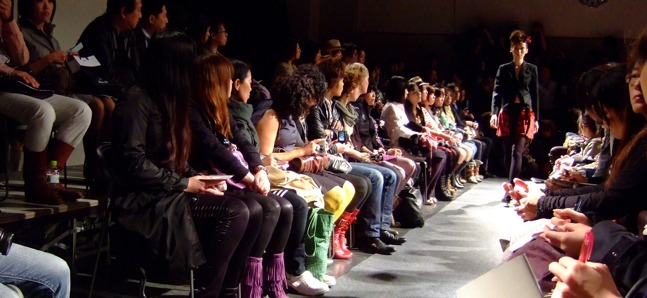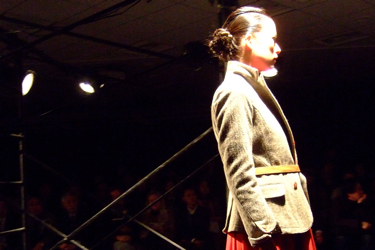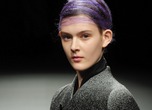Japan Fashion Week 2010 wrap-up
Our top picks, good bets, wild-cards and those found wanting

Junya Tashiro AW 10-11
Posted: Mon Mar 29 2010
The tenth instalment of Japan fashion Week has finally come to a close, and after the flurry of shows, blizzard of models and people constantly saying ‘I am so tired’, it’s now time to reflect what was seen and how to best put it to use.
Whether you want to know who had the best showings, feel the schadenfreude of a bad collection, or are trying to stretch yourself style-wise and need some ideas, here are our picks on those who are worth trying on for size, and those that can be passed up.
TOP PICKS

ENTOPTIC
Fittingly, for the first show of JFW, newcomers ENTOPTIC hit all the right notes. This is the kind of collection that Japan Fashion Week needs: cerebral but not indigestible, conceptual but still able to be worn in public and modern but with handmade accents that keep it grounded. Think soft jerseys hung off of thicker knits giving them movement, set off by leather elbow and knee patches. Cutwork was an aspect of this collection that highlighted versatility, being pulled off in a more subtle matter as the main component of a beautifully restrained mini-dress, and more boldly as a barely there, skeleton of a tunic. For those who are a bit more avant-garde, look for construction – moulded fabric studs, folds, volume and sleeves with gauntlet-like echoes. In the wearability department, many of the jackets and trousers in this collection will make for great minimalist suiting with a faint techno-punk twist.
The Individualist(s), A Label by Luise&Franck
The Paris-based German-French duo of Luise Schwarze and Franck Pouchoulin held their show at the Shinmai Creator’s project, a satellite project done by Japan Fashion Week and various sponsors to help promote fresh talent in the industry (hence the name shinmai, which means new rice). These ESMOD grads came up with a tight, cohesive collection of men’s and ladieswear that ran under the theme of ‘Crying Light’. Brooding, modern, clean but still warm, this collection kept a simple black-based colour palette that allowed cut, fabric and shape to come through in a sophisticated way. Look for the gorgeously tailored coats, and shredded accents that add a hint of chaos without being messy.
Factotum
This menswear label, headed up by Koji Udo showed under the National Stadium between concrete pillars, giving the show a bit of a ‘Mad Max’ feel. Perhaps it’s the bleak economy, or the preoccupation with apocalypse in the human subconscious these days, but despite whatever concept Udo may have had for this season, it was Cormac McCarthy chic – in a good way. Models loped down the runway wearing well-balanced layers of slim trousers topped with parkas, quilted jackets and duster coats covering artfully shredded shirts, surprisingly smart button-downs, sweatshirts and touchably thick knits in warm colours with pinks, reds and yellows thrown in for flavour. Compared to last season’s slick outlook, this time around things get a bit earthier and decidedly multipurpose that provides Factotum fans a chance to breathe as well and begin thinking about the surprises in store for next season.
Mint Designs
Hokuto Katsui and Yao Nagi brought another success to the table for AW 10-11. Though the headpieces (angular yet delicate constructions that amounted to architectural cages precariously perched on the models’ heads) were a bit dicey, the clothes were just what the concept set out to be: a fairytale. Charming and sweet without being cloying, pretty and delicate without losing intellect the clothes sent down the, err, National Stadium 100m running track were an eclectic blend of fabric patterns reminiscent of a Tudor house, traditional Japanese katagami stencil chrysanthemums, light brocades, and chiffons webbed in velvet. So together was the collection that the patterns were repeated in the quirky stockings on the models’ legs. For the season, the pair also included chunky knit gloves, furry knit trousers and shawls, as well as beautifully cropped and shaped coats that reigned in the airiness of the dresses.
Matohu
As one of the most looked-at collections of JFW, Matohu is arguably also one of the most modern and quintessential Japanese brands out there now. Hiroyuki Horihata and Makiko Sekiguchi employ an eye trained towards historical influence on modern sensibilities. This season’s keyword was kasane, or the layering of fabrics and colour schemes (kasane irome) influenced by nature, which became particularly important in the multi-layered kimono styles of the Heian Period Japan. AW 10-11 is comprised of colour combinations that make up our modern kasane irome from the city around us, and layers that are still functional a millennium later. Standouts include a very iki black coat that opens to reveal layered linings in silver, blue and yellow. Though the clothes may seem too bulky in the layering for some tastes, the individual pieces not only retain a historically poignant Japanese flavour, but also bespeak the Bunka-graduate design team’s background as pattern makers and will work just as well outside of the Matohu scheme of things.
@IZREEL
One-time mathematician Kazuhiro Takaura continues a tradition of sharp jackets and trousers dipped in a edge of eye-catching (but not over-thought) cool. In comparison to last season’s colour palette of silvers, this season things got warmed up a bit into a mix of greys, with splashes of mauve, leopard print, olive greens and houndstooth motifs. The styling scheme here perfectly kept things from getting too manufactured, with waist-tied sashes adding colour, movement and a tactile aspect. This collection was especially strong on coats, parkas, jackets and slim-to-the-max trousers.
Keita Maruyama
Prolific hometown designer Maruyama is at the head of a wide body of work including wedding and kimono lines. For AW 10-11, a sumptuous blend of 20s, 30s, and 40s flavours came together in slinky satins, full bodied wool coats, retro-styled mini-dresses with puffed sleeves and lingerie-inflected looks. Look here for flirty party frocks; something sensual but not predictably so.
GOOD BETS

The Dress&Co. by Hideaki Sakaguchi
After last season’s dress-heavy focus , AW 10-11 saw Sakaguchi’s act getting trimmed up a bit, and moving into the opposite direction, with Gucci-esque silk scarves, trad-chic knee-length trousers, blazers with trademark coat of arms, and an Amelia Earhart-meets-Lawrence of Arabia vibe with a bit of Daisy Buchanan thrown in. Though at times the collection felt somewhat predictable within its own sphere, pieces were inherently versatile and the tongue-in-cheek details (faux- porte-jarretelles print stockings) kept things from getting outright boring.
beautiful people
Something for the whole family here – as long as you are a young, hip family, that is. This season beautiful people featured looks for men, women, juniors and kids. The 3-D glasses sent with the show invitation left us scratching our head and hoping that Avatar would not make a showing. Instead, we were treated to a Beatles soundtrack and holier-than-Abercrombie well-scrubbed Americana montage of models looking like well-heeled parents taking their kids off to a prep school brought to you by Rolling Stone. Plaids and horse-blanket stitched capes had vintage Ralph Lauren on our minds, but then came the main event: 3-D prints. Models wearing chiffon blouses, dresses, shirts, scarves, and skirts that were done up in a pattern that was meant to look 3-D with the glasses on were a nice concept if a flop in practice, but they held their own anyhow. This was the only show we saw this week that had kids looks, which we hope to see more of from other designers. That being said, one of the more disconcerting points was the use of the Camel cigarette logo, or something very close to it, which was not only distracting but sent mixed signals next to the vibrant, youthful energy of the show. Overall, pieces from this collection will get a lot of mileage.
Support Surface
Just as the label name says, look for a lot of surface. This by no means ‘surface without substance’, but rather , that which falls into the realm of simplicity. No fussy devices or contrived mechanisms here; just Norio Surikabe’s clean lines, emphasis on texture and colour blocking, shaping and attention gently drawn to key areas on the silhouette. If you’re looking for unconventional yet subdued work wear, Support Surface has it in a muted, modern way. The collection was particularly strong on skirts with drape-infused shapes.
Mihara Yasuhiro
Much lauded for his Puma collaboration, Mihara Yasuhiro continues his strong legacy of mixing line, shape, texture, and construction to create something unconventional but still approachable. Dealing in mostly blacks, silvers and greys Mihara delivers some magnificent knits for both the men and the ladies. Sweater jackets, vests and straight-up sweaters resist being boring through volume and proportion play. The men’s sophisticated silvery-grey patchwork suiting is reflected in the ladies skirts, which helps to tie an otherwise fragmented collection together. If you’re looking for a chic but unpretentious coat or trench, check out the offerings here.
WILD CARDS

Junya Tashiro
Usually a more conservative leaning designer capitalising on natural shapes and juxtaposition of soft and structured, Tashiro took his sensibility into new territory. Whereas SS 10 sometimes veered off into hippie-wedding dress or old-fashioned cotton petticoat territory, this time we saw something more evolved and possibly traditional in the plaids, golds, blacks and lavish textures being sent down the catwalk. It might be a bit too Brigadoon for some, but the looks were sexy enough in some places, and loosely flowing enough in others that there was a sense of balance. True to his aesthetic, Tashiro utilised ruffling layers hemmed in by highly tailored and geometric outer layers which upped the allure factor in an unexpected way. Look here for more restrained party dresses with a saucy touch, dresses that might fit right in at a Tokyo wedding party and plaid coats sure to keep the chill away.
SOMARTA
Multi-faceted Tamae Hirokawa brings SOMARTA to life with influences from all corners of the design world. Her revolutionary Skin Series is based on a technologically advanced material designed to stretch and mould to amazing proportions both large and small. This time the lacy material was featured mostly as stockings, but the real pieces to watch for were the coats and jackets – cocooned, and richly shaped and draped they were the quiet attention point in an otherwise noisy and conceptual collection.
ODRADEK
Having debuted at last season’s JFW for SS 10, ODRADEK’s designer, Demian Celica Kanou, brings a unique perspective to menswear. Her experiences working with Camilla Staerk, Hussein Chalayan and Kenzo show through in crisply-tailored white shirts with thin colour line accents, solid suit jackets, peek-a-boo plaid pleats and slouchy capes. Never mind that the culottes are at best tricky; if you’re looking to put an arty twist to your suits for AW 10-11, then ODRADEK might be the line to look for.
jazzkatze
If you can get past the sheer fabrics, bodystockings, and the rather over the top Nefertiti hair, then you probably are daring enough to see the real-life applications of a handful of the garments from jazzkatze’s AW10-11 collection. In particular the grey knit and oxblood red leather dresses caught our eye. Too much? Moving on…
PHENOMENON
The man-skirt may only be able to be pulled off a certain kind of guy (few and far between, in our experience), but that is just a factor of styling. Skirts aside, PHENOMENON had its menswear moments for AW 10-11; more specifically – jackets and trousers. Get a couple of these and you have the makings of an anything-but-boring suit in colours like camel and brown. For the more adventurous, check out the armour-like epaulets on some of the coats that give off a more polished urban-warrior feeling.
Theatre Products
As with every season, Akira Takeuchi and Tayuka Nakanishi attempted to pull off another show with a theatrical message. Of course, they always receive points for concept, this time having the audience watch the press photographers (installed onstage) taking photos of the models as a sort of meta-synecdoche for the presentation of fashion in the formalised setting of a show.The colour palette was surprisingly pastel-laden for an AW show, and though some of the looks came off as a bit too saccharine, when the palette toned town, the beauty factor went up, with drape-shouldered patterned dresses, and more structured high-waisted trousers doubled with high-volume satin blouses.
Tiny Dinosaur
There were some good looks this time around, and definitely some individual pieces that wouldn’t look out of place in real life. Tiny Dinosaur was all about collars, with a double-breasted-like four button collar that featured heavily throughout. The idea has potential, but when thrown on to a white shirt with gold buttons, it just became pedestrian. The clear standouts of this collection were the pieces that made use of an almost batik-like print, and a ombré-style tie-dyed photo print. It was hit-and-miss at Tiny Dinosaur for AW 10-11, but the hits were solid and misses are not complete, and give them impression that there just might be something ready to break free next season.
FOUND WANTING
DRESSCAMP
With controversy swirling around the absence of design team head Marjan Pejoski, the collection that was easily one of the hottest invites in town felt more like a frustrated sigh than the roar that was expected after DRESSCAMP’S SS 10 showing. With a high wearability factor (which in itself is not a bad thing), we were expecting more surprises. The biggest surprise to be had was the fact that the best looks of the show were almost entirely on the menswear side of things, sporting well shaped suits, modified trenches and satiny-smooth trousers that still had a whiff of a macho edge. We expected more.
lessthan*
After seeing the collection, the label’s name perfectly characterised how we felt. One could see that Ohai Ando wanted to use a shadowy tie-dye as the defining characteristic of the collection, but it seemed that the slightly punked-up suit inspired separates that were paired with it either clashed with or got lost in it. The shapes were too blocky and contrived, making the overall effect uncomfortable and very off-target. Nice try and better luck next time.
G.V.G.V.
This was almost like four separate collections in one for designer Mug, a UNIQLO collaborator. Opening with Bauhaus’s ‘Bela Lugosi Is Dead’, the show broke open with a slightly demonic perspective featuring shirts, jackets, and dressing-gown like robes with red pentagrams, fringe, patent leather, and satins. Somehwere along the way, it turned into beige and white suits, colour blocking, and then morphed into a rather sloppy, tired Harajuku-street impression seen through an LA lens, with darkly boho skirts and satin sukajan jackets with a California twist, finishing with a red velvet maxidress. Maybe there was a more subtle point that Mug was trying to get across with this collection, but with such an aggressive execution it was lost along the way.
TROVE:
Though TROVE is consistently wearable, this collection swung too far in that direction. In the past TROVE has played with construction, and thrown in shapes that broke up the look a bit and kept the eye engaged, but this time the clothes seemed to drown out the wearer with sheer utility. Will they keep you warm? Yes. Do they look presentable? Yes, even nicely so. But that’s about it.
fur fur.
Last season was a dressing-up box, this season it was either a Scandinavian St. Lucia’s day, a wedding, or a quasi-Victorian maid funeral. The white component of the collection was complete with candle crown and white gowns, or cake-like dresses that made our teeth hurt. The black portion looked like a procession of dolls dressed in floppy widow’s weeds. Endearing as costume pieces, but confusing as to how to adapt them to everyday wear, all it really is is a lateral move from SS 10. Here’s hoping for next season.
Related articles:
・JFW 2010 forecast
Next week’s labels to watch
・From Miyake to Meguro
Designer Michail Gkinis strikes a balance with aptform
・Find Tokyo’s trendiest labels
The spots to shop for the hottest in young Japanese fashion design
Tags:
Tweets
- About Us |
- Work for Time Out |
- Send us info |
- Advertising |
- Mobile edition |
- Terms & Conditions |
- Privacy policy |
- Contact Us
Copyright © 2014 Time Out Tokyo











Add your comment